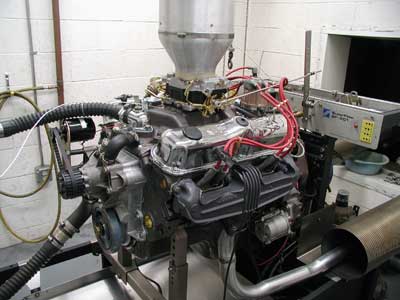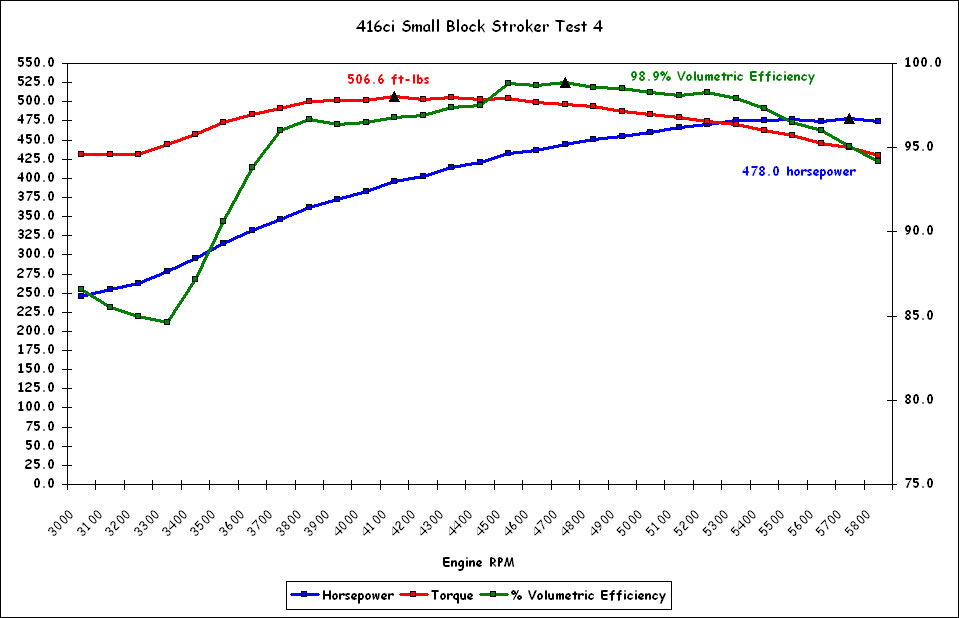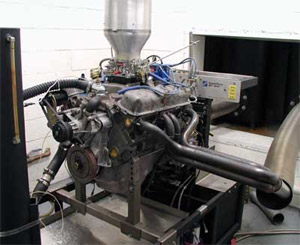|
|
#8---408 & 416 Stroker Dyno Testing Sept. 2002 | 12/10/2021 |
|
The following are dyno tests of the popular Small Block stroker engines. These engines are essentially the same, depending which block was used. Due to its larger stock bore, the 340 block yields about 6 more cubic inches than the stroked 360.
The first test was a 360 block with the 4" stroke (360/408) that was built to be what we call a "stealth" build-up. In other words it was to look like a stock 360 engine (1978 Lil' Red Express truck) on the out side, but be well modified on the inside. It used the original 1978 block, heads, cast iron intake and exhaust manifolds, oil pan, distributor, and air cleaner. The inside of the engine was far from stock condition. We modified everything in an effort to get as much out of the limited breathing capacity of the OEM intake and exhaust systems as possible.
Starting at the bottom and working up:
The crank kit was our #408K-Street. This kit features KB pistons, Eagle rods, and the 4" stroke Mopar crank, it is internally balanced and will yield a nice pump gas 9.4:1 compression with a 65cc head. The KB pistons have a quench dome which works perfectly with the stock open chamber heads.
The block had our usual preparation which, among other things, includes Magna-fluxed, block, ultra-sonic tested to determine cylinder wall thickness, line honed, square decked. Bored and honed with a deck plate and our modified oil system .Proper decking gave us an ideal 0.035"/0.040" quench height so we don't have to run a bunch of total timing, anything over 30 degrees is damaging and power robbing.
We did not use the original '051 heads; we substituted a better set of '596's. They were ported to our Stage II HP specs and flowed about 296 CFM at 0.600" lift on our bench. The valves were our 2.02" #1006; we now use the 2.05" #1007 for improved flow curves. The exhaust was our 1.625" p/n 1014; both valves had 11/32" stems. The camshaft was an earlier version of what is now our HUG HEH3742AL grind with our 1.6:1 aluminum roller rockers new. The springs are our double spring and our HUG 1202 retainers and HUG 1322 locks. The pushrods were custom length based on HUG 5479 . The lifters HUG 5003 and our premium timing chain assembly HUG 6442 with the 7 key-way crank sprocket. 
The photo to the right shows the engine ready for the first dyno pulls, before the carb switch. |
The stock iron intake was deep port matched and had some plenum work. The exhaust manifolds (they are ugly) are stock with 2 " exhaust pipes. Whenever we do stealth engines we get questions about extrude honing the exhaust manifolds. For about $500.00 you may get 6 to 8 horsepower, I think your money could be better spent, on coatings for example. We originally tried an owner supplied and re-worked Thermo-quad carb as shown in the photos. This carb was a problem early on (the engine would not start) and we switched to a shop carb, a 750 Edelbrock that has seen many dyno tests and is a reliable piece. A good Thermo-quad could be worth a little more power, maybe! See Test #1 below.
We have included a volumetric efficiency column with this test. Some of you may not be familiar with this chart. The chart lists in percentage how efficient the engine is breathing, among other things. In this test the percentage is not too good as we are accustom to seeing numbers much closer to 100% or greater. Why? Why indeed! We are doing it to make a point. As noted previously we had tried to disguise this "stealth" engine as a stocker, hence we had to use the original 1978 truck type manifolds. |
| 408ci Stroker Test 1 |
Engine
RPM |
Corrected
Horsepower |
Corrected
Torque (ft-lbs) |
% Volumetric
Efficiency |
| 2500 |
163.1 |
342.6 |
79.2 |
| 2600 |
169.5 |
342.4 |
77.3 |
| 2700 |
177.5 |
345.3 |
76.8 |
| 2800 |
189.2 |
354.9 |
76.4 |
| 2900 |
199.3 |
361.0 |
78.1 |
| 3000 |
206.2 |
361.1 |
80.1 |
| 3100 |
213.3 |
361.4 |
80.6 |
| 3200 |
224.0 |
367.6 |
80.4 |
| 3300 |
239.4 |
381.0 |
81.3 |
| 3400 |
254.8 |
393.5 |
81.8 |
| 3500 |
270.5 |
405.9 |
83.9 |
| 3600 |
279.2 |
407.3 |
83.8 |
| 3700 |
292.3 |
414.9 |
85.1 |
| 3800 |
303.1 |
419.0 |
85.6 |
| 3900 |
310.0 |
417.5 |
85.6 |
| 4000 |
321.3 |
421.9 |
85.9 |
| 4100 |
333.9 |
427.8 |
87.4 |
| 4200 |
343.6 |
429.7 |
87.8 |
| 4300 |
350.0 |
427.4 |
87.6 |
| 4400 |
357.4 |
426.6 |
87.7 |
| 4500 |
362.9 |
423.5 |
88.1 |
| 4600 |
368.0 |
420.2 |
88.0 |
| 4700 |
377.6 |
421.9 |
87.8 |
| 4800 |
382.1 |
418.1 |
87.5 |
| 4900 |
389.9 |
418.0 |
87.1 |
| 5000 |
392.3 |
412.1 |
88.4 |
| 5100 |
400.0 |
411.9 |
88.6 |
| 5200 |
400.5 |
404.6 |
87.2 |
| 5300 |
408.6 |
404.9 |
86.8 |
| 5400 |
409.2 |
398.0 |
86.1 |
| 5500 |
406.9 |
388.6 |
86.0 |
|
Results: 409.2 HP @ 5400RPM and 429.7 ft-lbs torque @ 4200RPM
Click here for larger image

|
In Test 2 we switched to a pair of TTI, stepped headers, 1 5/8"/ 1 ". To say the difference is amazing is a gross understatement! Check the header photos below.
The power was up 42 hp and torque up 85 ft-lb at only 2600 RPM. And the improvements just kept coming with a maximum improvement for the horsepower at 4900 RPM with 66HP more and the torque was up 72 ft-lb at 4800 RPM, WOW! Note that the volumetric efficiency is up only 6 to 10% but look at what a difference just that little bit made in horsepower and torque. The engine was breathing much better. In all honesty any headers would have helped this engine, even the dreaded "shortys", but I doubt any others would have shown as much improvement as the . When you contact to order, tell Stan that we sent you!
|
| 408ci Stroker Test 2 |
Engine
RPM |
Corrected
Horsepower |
Corrected
Torque (ft-lbs) |
% Volumetric
Efficiency |
| 2600 |
211.7 |
427.6 |
85.0 |
| 2700 |
221.2 |
430.3 |
83.9 |
| 2800 |
232.3 |
435.6 |
83.6 |
| 2900 |
240.6 |
435.8 |
83.2 |
| 3000 |
246.6 |
431.7 |
83.0 |
| 3100 |
252.2 |
427.3 |
82.3 |
| 3200 |
257.5 |
422.7 |
82.7 |
| 3300 |
265.5 |
422.6 |
82.3 |
| 3400 |
279.8 |
432.2 |
83.3 |
| 3500 |
291.3 |
437.1 |
82.8 |
| 3600 |
302.5 |
441.4 |
84.2 |
| 3700 |
315.0 |
447.2 |
85.8 |
| 3800 |
329.2 |
455.0 |
86.5 |
| 3900 |
345.7 |
465.6 |
90.6 |
| 4000 |
362.9 |
476.5 |
92.2 |
| 4100 |
375.6 |
481.1 |
92.7 |
| 4200 |
394.4 |
493.2 |
93.3 |
| 4300 |
404.4 |
493.9 |
94.6 |
| 4400 |
417.2 |
498.0 |
94.9 |
| 4500 |
426.1 |
497.3 |
96.8 |
| 4600 |
432.9 |
494.3 |
97.0 |
| 4700 |
441.7 |
493.5 |
96.6 |
| 4800 |
448.1 |
490.3 |
97.1 |
| 4900 |
456.1 |
488.8 |
96.9 |
| 5000 |
457.7 |
480.8 |
96.1 |
| 5100 |
463.8 |
477.6 |
97.3 |
| 5200 |
468.3 |
473.0 |
96.6 |
| 5300 |
471.6 |
467.3 |
95.9 |
| 5400 |
471.5 |
458.6 |
95.2 |
| 5500 |
469.4 |
448.3 |
94.5 |
| 5600 |
465.0 |
436.1 |
93.2 |
| 5700 |
460.2 |
424.0 |
92.9 |
| 5800 |
463.5 |
419.7 |
91.9 |
| 5900 |
464.3 |
413.3 |
91.1 |
|
|
The tests below are similar to Tests 1 and 2 in that it is another stealth build-up, but a 340ci HP engine is used as the basis.
Again, we used our basic, 4" Mopar Performance crank, Eagle rods, and KB pistons (416-KSTREET) Stroker Kit. At +0.030", it is 416ci. We used the same cam as our earlier version, which is now our HUG HEH3742AL cam, with our 1.6:1 roller rockers - current part number 1506S-16, 1111 springs, HUG 1202 retainers and HUG 1322 locks.
The block was prepared the same as in Test 1 and 2 with the 360/408. The heads were the original equipment '894 "X" heads with our 2.02" valve #1006 then, now it would be a 2.05" valve, #1007, for improved flow curve like in the '596 used in the 360/408 Test #1 and #2. The exhaust remained our #1014, 1.625" valve. Both valves had 11/32" stems. The heads had our Stage II HP porting with a nice fat curve resulting in about 275 cfm @ 0.550" lift. The pushrods were custom length--HUG 5479. The lifters were our HUG 5003, and we used our premium timing chain, HUG 6442.
The intake was the original high-rise 4BBL iron intake from the original 340 HP engine. It was extrude honed, deep port matched and plenum worked like the 360/408 Test 1 and 2. The exhaust manifolds were also the original 340 HP units' that were extrude honed, again with same 2 " exhaust pipes. This engine also had a modified Mopar Performance windage tray. We again used the 750 Edelbrock carb.
This test somewhat answers the question of how good are the 340 HP parts, such as the cast iron high-rise 4 4BBL intake and the HP exhaust manifolds, compared to the plain 360 parts as used in the base 360/408 test. The extrude honing and 8 more cubic inches did help the 340 parts, I would guess maybe 12-16 more horsepower altogether. Nevertheless, the good iron parts are much better. No wonder they sell for so much at swap meets!
|
|
416ci Stroker Test 3
|
|
Engine
RPM
|
Corrected
Horsepower
|
Corrected
Torque (ft-lbs)
|
% Volumetric
Efficiency
|
|
3000
|
226.1
|
395.8
|
86.0
|
|
3100
|
235.6
|
399.1
|
85.4
|
|
3200
|
243.9
|
400.3
|
85.3
|
|
3300
|
264.5
|
421.0
|
86.3
|
|
3400
|
280.3
|
432.9
|
87.6
|
|
3500
|
293.0
|
439.7
|
88.6
|
|
3600
|
304.1
|
443.6
|
89.4
|
|
3700
|
316.5
|
449.3
|
91.1
|
|
3800
|
329.4
|
455.3
|
90.8
|
|
3900
|
339.4
|
457.1
|
90.6
|
|
4000
|
352.4
|
462.7
|
90.6
|
|
4100
|
364.6
|
467.1
|
91.5
|
|
4200
|
374.6
|
468.4
|
92.3
|
|
4300
|
385.6
|
471.0
|
92.8
|
|
4400
|
394.4
|
470.8
|
93.3
|
|
4500
|
401.7
|
468.9
|
93.8
|
|
4600
|
406.3
|
463.9
|
93.5
|
|
4700
|
412.9
|
461.5
|
92.8
|
|
4800
|
419.0
|
458.4
|
92.4
|
|
4900
|
425.1
|
455.7
|
92.6
|
|
5000
|
434.0
|
455.8
|
93.2
|
|
5100
|
441.5
|
454.6
|
93.0
|
|
5200
|
441.3
|
445.7
|
92.7
|
|
5300
|
443.8
|
439.8
|
91.8
|
|
5400
|
446.7
|
434.5
|
91.3
|
|
5500
|
442.5
|
422.5
|
90.3
|
|
5600
|
448.2
|
420.3
|
89.6
|
|
5700
|
445.4
|
410.4
|
88.9
|
|
5800
|
439.4
|
397.9
|
87.8
|
|
|
|
This next test, #4 was a change to headers. These were the dyno headers (like oval track) that were stepped 1 5/8" to 1 ". Notice how the volumetric efficiency jumped up and the power came right along with it.
|
| 416ci Stroker Test 4 |
Engine
RPM |
Corrected
Horsepower |
Corrected
Torque (ft-lbs) |
% Volumetric
Efficiency |
| 3000 |
246.0 |
430.6 |
86.6 |
| 3100 |
254.7 |
431.6 |
85.5 |
| 3200 |
262.7 |
431.2 |
85.0 |
| 3300 |
278.8 |
443.7 |
84.6 |
| 3400 |
295.6 |
456.6 |
87.2 |
| 3500 |
315.2 |
473.0 |
90.6 |
| 3600 |
331.8 |
484.0 |
93.8 |
| 3700 |
346.3 |
491.6 |
96.0 |
| 3800 |
361.6 |
499.8 |
96.7 |
| 3900 |
372.8 |
502.0 |
96.4 |
| 4000 |
382.3 |
502.0 |
96.5 |
| 4100 |
395.4 |
506.6 |
96.8 |
| 4200 |
402.5 |
503.3 |
96.9 |
| 4300 |
414.2 |
505.9 |
97.4 |
| 4400 |
421.2 |
502.8 |
97.5 |
| 4500 |
431.8 |
504.0 |
98.8 |
| 4600 |
436.9 |
498.8 |
98.7 |
| 4700 |
444.2 |
496.4 |
98.9 |
| 4800 |
451.1 |
493.6 |
98.6 |
| 4900 |
454.6 |
487.3 |
98.5 |
| 5000 |
460.2 |
483.4 |
98.3 |
| 5100 |
466.2 |
480.1 |
98.1 |
| 5200 |
469.8 |
474.5 |
98.3 |
| 5300 |
474.9 |
470.6 |
97.9 |
| 5400 |
475.9 |
462.9 |
97.3 |
| 5500 |
477.4 |
455.9 |
96.5 |
| 5600 |
474.8 |
445.3 |
96.0 |
| 5700 |
478.0 |
440.4 |
95.1 |
| 5800 |
474.8 |
430.0 |
94.2 |
|
Results: 478.0 HP @ 5700RPM and 506.6 ft-lbs torque @ 4100RPM
Click here for larger image

 |
Test 5: We installed an Edelbrock RPM inake with a deep port match and reached over 100% efficiency. But at this point the cam was showing its small size for such a large displacement, carb, intake, heads, and headers - all of which would benefit from a larger solid cam. Remember all the parts must grow (increase in size) together or the entire package would be held back. This cam may have liked the Edelbrock RPM intake better, especially at the low end. With a larger cam the single plane is the best choice.
Note the horsepower and torque did not drop off of any of the higher-powered engines, even at RPM's as low as 3000 RPM. This demonstrates how street friendly our cams can be at 500 horsepower.
Conclusion:
It is important to note that there is tremendous power potential in a properly built 4.00" stroker. A solid cam, more compression, some ported Edelbrock heads - and 600 horsepower becomes a reality.
Remember, the engines shown here are pump gas, 92 octane-friendly, and use a very streetable hydraulic cam. High power doesn't have to hurt the low end, if you do it right.
|
| 416ci Stroker Test 5 |
Engine
RPM |
Corrected
Horsepower |
Corrected
Torque (ft-lbs) |
% Volumetric
Efficiency |
| 3000 |
240.4 |
420.8 |
84.9 |
| 3100 |
252.1 |
427.1 |
83.4 |
| 3200 |
270.8 |
444.5 |
85.3 |
| 3300 |
281.9 |
448.7 |
86.4 |
| 3400 |
295.8 |
457.0 |
86.9 |
| 3500 |
314.0 |
471.2 |
88.3 |
| 3600 |
330.1 |
481.5 |
92.3 |
| 3700 |
346.8 |
492.2 |
93.6 |
| 3800 |
363.6 |
502.5 |
95.0 |
| 3900 |
379.1 |
510.5 |
96.2 |
| 4000 |
389.1 |
510.9 |
96.2 |
| 4100 |
401.2 |
514.0 |
97.0 |
| 4200 |
412.6 |
516.0 |
97.3 |
| 4300 |
420.4 |
513.5 |
97.7 |
| 4400 |
429.9 |
513.1 |
98.7 |
| 4500 |
439.1 |
512.5 |
99.0 |
| 4600 |
446.6 |
509.9 |
99.1 |
| 4700 |
454.3 |
507.7 |
98.7 |
| 4800 |
467.3 |
511.3 |
100.7 |
| 4900 |
475.7 |
509.9 |
100.8 |
| 5000 |
480.0 |
504.2 |
100.5 |
| 5100 |
486.1 |
500.6 |
100.5 |
| 5200 |
490.3 |
495.2 |
100.7 |
| 5300 |
498.3 |
493.8 |
101.2 |
| 5400 |
498.6 |
485.0 |
100.2 |
| 5500 |
502.0 |
479.3 |
99.5 |
| 5600 |
502.1 |
470.9 |
99.1 |
| 5700 |
502.9 |
463.4 |
98.4 |
| 5800 |
496.4 |
449.5 |
97.3 |
|
Results: 502.9 HP @ 5700RPM and 516.0 ft-lbs torque @ 4200RPM
Click here for larger image

|
|
|
|



